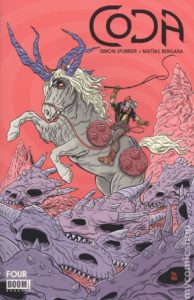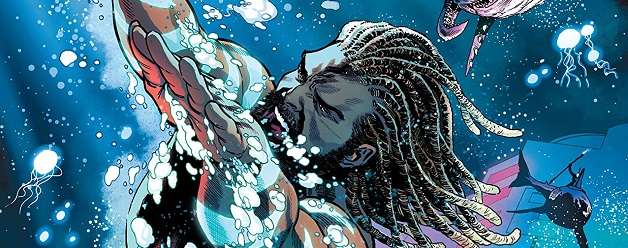 Coda #4
Coda #4
Publisher: Boom! Studios
Story: Simon Spurrier
Pencils: Matías Bergara
Inks: Matías Bergara
Colors: Matías Bergara; Michael Doig
Letters: Jim Campbell
Cover: Matías Bergara
The first issue of Coda was a genre-bending delight, a post-magic apocalyptic fantasy that combined elements from Tolkien, Mad Max, Ralph Bakshi’s Wizards, and other disparate influences. While the concept was intriguing, there was the possibility that it could fizzle out too quickly, becoming gimmicky and predictable. Thankfully, the most recent issue puts those fears to rest by continuing to maintain the mystery and creativity of the story’s premise.
Issue number four opens with a lovely sequence of visuals by Matías Bergara with an accompanying lyrical poem by the series protagonist, Sir Hum (aka “X”), finally telling the story of the events that led to the Quench, the term the inhabitants of this world use for the apocalyptic event that destroyed magic. The images are haunting, with an almost monochromatic coloring style that creates a sense of loss and sadness. Having the sequence narrated as a poem crafted by X, using his bardic abilities, was a nice touch by Spurrier to keep the attention on the characters rather than simply acting as a piece of world-building.
However, speaking of world-building, Spurrier and Bergara are masters, and they continue to drop small comments that, combined, have a much larger effect in terms of fleshing out the world. Serka, X’s wife, mentions that she has “the Helm of Vrogam’s Might and the Shield of Confabulation” and while these items are not explained at all, that hardly matters, as they point to the existence of powerful artifact items in the world, and that more might also exist. While out riding, X and Serka come across an “Almiraj,” an obscure mythological creature from the mysterious “Sea Serpent Island” in the Indian Ocean, mentioned in Zakariya Ib Muhammad Al-Qazwini’s The Wonders of Creation, but one which this reviewer first encountered when reading the old Advanced Dungeons & Dragon’s Fiend Folio as a boy. That Spurrier uses these types of non-traditional mythological creatures in his story, rather than the standard orcs, trolls, and dragons, helps to define the world and help the fantasy actually be fantastical.
Bergara’s art throughout the series is a type of “detailed exaggeration” – characters and living creatures, particularly, are exaggerated to an almost cartoon-like quality, and yet maintain a level of detail in facial expressions and body language that convey emotions better than many so-called “realistic” comic artists. At times, his coloring evokes an almost psychedelic quality that also helps define the fantasy world he and Spurrier are creating.
Most interesting in this issue is the nature of X’s relationship with his wife, Serka, for whom he has been searching for the first few issues on his “mission” (he chastises the reader in the first issue to definitely not refer to it as a quest). Her background is more fully explained in the opening section of this issue, and further detailed in the following story. Spurrier creates an interesting turn of events after X finds his wife, and her unexpected reveal, combined with the reckless act by X revealed on the final page of this issue, appears to set up the remainder of the issues in this 12-issue series.
Coda continues to supply the right balance of comedy, romance, action, and world-building, combined with a unique art style, to make this the very best in non-traditional fantasy.
Martin Thomas
martin@comicattack.net



